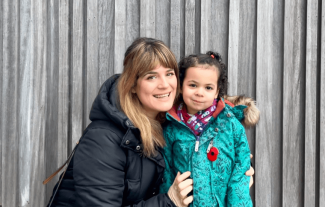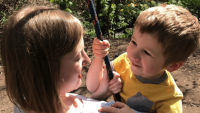Lessons from a pre-schooler

Amanda Cullen writes about her daughter's journey with speech and language therapy, the emotions tied to being a parent of a child who stammers, and the lessons she's learned along the way.
"Hi, I'm Sophia, sometimes my words get stuck!", was the cheerful greeting my daughter gave to her pre-school teacher upon meeting her. While it is typically a surprise to adults how unapologetically candid children are, it is an example we can all benefit from.
Six months prior to Sophia starting pre-school, at the first experience of our usually chatty daughter's stammer my husband and I looked at each other with a tilt of the head and a shrug of the shoulders. We didn't think anything of Sophia's occasional disfluencies and my background in early childhood education reminded me that disfluency is a typical part of child development. After all, Sophia was only 3 and her speech development was taking off in leaps and bounds.
- Our Help If Your Child Stammers page has information on supporting you and your child.
Unexpectedly, in the upcoming days Sophia's stammer became increasingly more obvious. Before we realised, her sentences filled with lengthy prolongations, jammed words that made her grimace with fear and frustration, and she was now beginning to avoid words that she once uttered with ease.
I could see Sophia's face mirror the concern in her doctor's tone, a moment that will forever be etched into my memory. It was the first time I noticed shame and concern wash over my daughter triggered by something she had no control over.
At our paediatrician wellness visit I mentioned our growing concerns regarding Sophia's new stammer. I explained the unease we were feeling concerning Sophia's frustration and her new avoidance of words, which was met by our doctor's immediate reassurance that this was a completely typical and predictable experience of speech development. As we were wrapping up our appointment Sophia began to ask me what we were going to have for lunch. Her sentence, flooded with repetitions and escorted by a long prolongation, made the doctor stop in her tracks. "Is that the type of stammering she's been displaying?", she said as she pointed to Sophia. I could see Sophia's face mirror the concern in her doctor's tone, a moment that will forever be etched into my memory. It was the first time I noticed shame and concern wash over my daughter triggered by something she had no control over. We were referred to a neurologist due to our paediatrician's concerns, which only magnified our anxiety.
Acknowledgement
Throughout the following weeks, as Sophia's stammer continued, we spoke to multiple speech and language therapists (SLTs) who suggested we find an SLT who specialises in stammering. Our search took a fortunate turn when we contacted a former professor of mine who happened to be an SLT and specialist in paediatric stammering. The first thing this SLT made us aware of was the fact that we had yet to acknowledge to our daughter that we had noticed her struggling to get her words out. Sophia, who can be considered an emotionally sensitive child, was accustomed to constant acknowledgment of her feelings and had certainly become aware of our unease regarding her new way of speaking. It's no surprise that our silence made the experience even more daunting for her.
Sophia's speech journey has allowed me to recognise that speech is deeply tied to our emotions, self-expression and identity.
So, with the advice of our SLT, the next time Sophia stammered we looked her in the eye and unceremoniously said, "Ah, it seems like your words are getting stuck. That happens sometimes; speaking can be hard!". At that moment I could see the tension and fear slowly fade from Sophia's face. There was now vocabulary to describe her stuck words, a response to her struggle, the understanding that no matter how hard it is to say something, someone is listening with baited ears.
Fostering confidence
Sophia's newfound confidence regarding her stammering was the perfect way to begin speech therapy. Over the next several months we continued to foster her confidence and worked on not only strategies for Sophia to implement during speech, but strategies for us as her parents to practise. Surprisingly, our sessions didn't consist of focusing on diminishing Sophia's stammer, but rather providing Sophia with alternatives strategies to use in order to avoid gaining unhelpful coping mechanisms and frustration that might lead to her shutting down. Sophia seemed to thoroughly enjoy her therapy sessions and would soon confidently announce any time her words got "stuck".
- Find out about our free workshops and support group for parents.
Sophia's speech journey has allowed me to recognise that speech is deeply tied to our emotions, self-expression and identity. I've found that as greatly as we strive to be heard, we thrive on human connection, be it through conversation, acceptance or positive reinforcement. As I'm currently completing my master's degree in Speech and Language Therapy, I am guided by my experience of being the mother of a child who stammers. My daughter has taught me that just as with speech, life will have some (or many) bumps and our success isn't measured on solely effortlessness. Perhaps self-acceptance is our most important journey.
If you've enjoyed reading Amanda's article and have found her experience helpful, please consider making a donation. Donating to STAMMA means that we can carry on sharing stories from members of our community which inspire and encourage others on their stammering journeys. Read more inspiring stories.
We'd love to hear your about your experiences. If you would like to write an article, see Submit Something For The Site or email editor@stamma.org

































